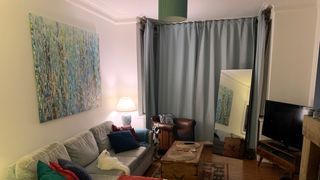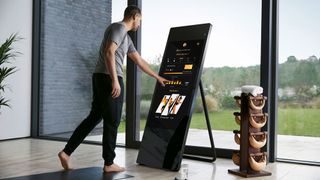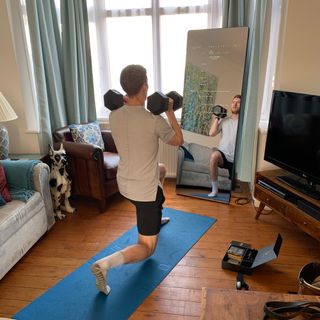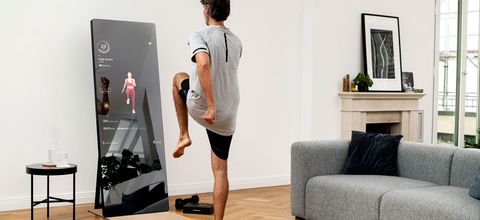Our Verdict
Fitness mirrors remain a tough sell and VAHA’s workouts aren’t as compelling as those in the best workout apps, but the two-way functionality and ability to run apps like Zoom set it apart from other mirror manufacturers.
For
- Two-way interactivity
- Can book a private PT session and receive a tailored programme
- Looks great
- Compatible with third-party apps like Spotify, Zoom and Instagram
Against
- Expensive for a person-sized smartphone
- Limited metric tracking
- Workouts can be a tad boring
You can trust Coach
VAHA will always be able to say it was here first. In April, the German-based company became the first smart mirror brand to launch in Britain. At first glance, the VAHA X appears to be an elegant full-length mirror, but it is in fact a giant touchscreen that can stream live and on-demand exercise classes, connect you with a coach for a one-to-one PT session, and lets you take Zoom video calls and Instagram selfies.
VAHA is a spin-off from a digital physio product called Pixformance, which is used by more than 600 fitness studios and hospitals in 11 countries. Founder Valerie Bures – who also co-founded Europe’s largest women’s fitness chain, Mrs Sporty – launched the smart mirror in Germany in 2019. She believes this background will give VAHA the edge in a rapidly growing category of home gym equipment.
In the US, rivals Mirror and Tonal will be hard to dethrone. Sales of both surged during the pandemic as the nation scrambled to bring the gym home. Now VAHA has brought the smart mirror party to these shores there’s every chance the US brands won’t be far behind.
The Set-Up
VAHA X is a stunning bit of design and engineering that would, as all good mirrors should, make any room feel bigger and brighter.

Made of steel, brushed aluminium and glass, the 170x62x4cm free-standing device houses a high-resolution display and – to enable two-way communication – a camera, speaker and microphone. It’s like a human-sized iPhone.
It comes preloaded with popular apps, including Firefox, Spotify, Instagram, TikTok and Zoom, should you want to conduct your team meetings from your sitting room. A heart rate monitor, resistance bands, microfibre cloth and glass cleaning spray are also included in the box. With a rolling monthly subscription you can access live group classes and over 200 on-demand workouts, including strength, cardio, boxing, yoga, Pilates, barre and even guided meditations.
Smart motion tracking that provides instant feedback using AI technology is, we’re told, also in development, which will analyse your movements to help correct your form. This feature would certainly have set VAHA’s mirror apart, but we’ll have to wait to see if it lives up to the billing.
At £1,950 – or 39 monthly installments of £50 – VAHA X is a sizeable investment and on the expensive end of smart mirrors, when measured against Mirror (£1,088) and Tonal (£2,180). The hardware isn’t the only outlay either. VAHA’s basic membership costs £39 a month (Mirror’s is £28 and Tonal’s £36). A minimum 12-month commitment is also required, but this does include a free PT session in your first month.
VAHA’s £200 delivery fee is also supposed to include unpacking and placement in your home, but this was news to the chaps who delivered my device, perhaps because it conflicted with COVID measures still in place in mid-April. Instead, I was left with an enormous cardboard container occupying prime real estate in my sitting room.
Eventually I convinced my wife to help me unpack the 45kg beast and, after a bit of feng shui, found a suitable corner to prop it up in using the stand. For anyone au fait with lockdown workouts via video calls, you’ll know positioning your laptop or mobile so you’re in full view of the instructor can be a headache. Fortunately, with VAHA you only need enough space to stand, squat or lunge in front of your device to be in view.
Once in position and plugged into the mains, set-up was relatively swift. A tap of the 43in (109cm) HD touchscreen brings the device to life and navigation is pleasingly intuitive. What wasn’t so simple was pairing the device with the heart rate monitor. Disconnecting my mobile from almost every Bluetooth-enabled device in my house eventually did the trick.
The device prompts you to connect to your WiFi and log in to a Spotify account, which is what the VAHA X uses to soundtrack its classes. Each class comes with a suggested playlist but you can choose your own soundtrack if you like. Unfortunately, if you use the free version your workout playlist will be interrupted by ads.
From the home screen you can navigate to “Classes” for on-demand workouts categorised by discipline, difficulty and duration, “Live Classes”, which is self-explanatory, and “Journey”, your tailored workout plan.

The Experience
To kick things off, VAHA recommends you book a free live assessment with one of its expert coaches. My one-to-one is with Laura, a PT based in Berlin, which I booked via VAHA’s mobile app while waiting for the mirror to arrive.
In my initial video consultation Laura runs through my training experience, objectives, exercise likes and dislikes. She critiques my ropey form on a few bodyweight exercises, and then promises to design me a bespoke training plan I can follow over the next month. You can add a PT subscription to your membership for one, four, eight or 12 sessions like this per month.
Two days later my plan is ready on the device, with a daunting variety of intermediate and advanced strength, cardio, yoga and Pilates classes lined up each day.
On day one, I jump into an on-demand 30-minute lower-body “Build” class with a trainer called Lauren, which requires a pair of dumbbells – luckily I acquired a pair of weights midway through the first lockdown (at eye-watering expense). Don’t worry if you’re without kit – the bodyweight classes, as I find out, are fully capable of kicking your arse.

At the start of the workout, Lauren appears in the centre of the screen like a hologram floating against a blacked-out background. Rather than use its full length, VAHA’s screen section only occupies the middle half of the mirror, so Lauren is in miniature form, rather than life size. In the top left the time of each session counts down. In live classes the names and profile images of other users run along the bottom, but these were all at awkward times in the middle of the day so I typically opted for pre-recorded workouts.
Having gone through the rigmarole of setting up the heart rate monitor earlier, I found the metrics VAHA track fairly limited. A thin bar on the left of the instructor indicates your pulse, and during cardio classes it will also show if you’re in the correct “cardio burn” zone. In all other classes it merely shows your heart rate, but doesn’t use this to tell you how many calories you burned, if your fitness is improving or any of various simple metrics other connected brands give you. The workout app Fiit, for example, uses an accelerometer built into its heart rate device, or syncs with Apple Watch, so you can even track reps completed of certain moves.
The workout itself certainly lived up to its advanced billing. After a thorough warm-up, a series of lunges follow squats follow curtsy lunges follow cossack squats, until my legs become jellified and I’m cursing the instructor with every rep. Thankfully, Lauren can’t hear me, but I can see my form rapidly deteriorating in the reflection, which prompts me to tidy up my technique.
Throughout the class, Lauren is calling out encouragement for “Manuel in Munich” and “Vanessa in Berlin”. While this hints at an engaged VAHA community, all pulling together to survive another minute of jump lunges, without the two-way interaction it simply felt distracting and reminded me I was watching the rerun and not the live performance.
The class finished with a cursory warm-down, then returned me to the home screen, which displays how many minutes of workouts I’ve completed over the month. It also compares your activity time with your previous month, and that of the VAHA community. It’s like a screen time tracker on your mobile, only the goal is to spend more time gazing at your device, rather than less.
Verdict
Unfortunately for VAHA, its UK launch on 12th April coincided with the lifting of many lockdown restrictions including the reopening of gyms in England. So they were always fighting an uphill battle against home workout fatigue.
All the same, the mostly pre-recorded workouts I took were fairly uninspiring, and I often found my attention wandering mid-class. VAHA isn’t that visually stimulating compared with the production values of other video workouts. There are no on-screen cues of how many reps have been completed or how long is left in each set. Classes rely on the enthusiasm of the coach and music to keep you engaged, which for the most part is enough, but I found some workouts felt repetitive and unimaginative, a poor imitation of the real boutique studio experience.
However, I did find myself using VAHA’s Pilates and yoga classes to complement workouts at my now-reopened CrossFit box. Having inevitably pulled my back getting reacquainted with the squat rack, I also found the 15-minute stretching drills invaluable when my body wouldn't allow me to do anything more strenuous.
Judging by the admiring comments friends made when they saw the device, VAHA’s smart mirror is certainly pleasing on the eye. A soon-to-launch, more affordable and compact VAHA S model at £1,150 will make it more attainable.
If you have an abundance of cash VAHA is a smart piece of kit and an upgrade from following PE With Joe videos on your laptop. But while I can understand the appeal of a hi-tech bike from Peloton, treadmill from Echelon or rowing machine from Hydrow, when you need the kit to experience that specific form of exercise, with bodyweight or dumbbell exercises there’s no real need to have a six-foot-tall sheet of glass in front of you for an effective workout.
Mirror recently partnered with premium hotel group Mandarin Oriental to install devices in suites as an extension of the hotel wellness facilities. That feels like a more natural fit for a luxury gadget like VAHA. Until the German company’s extras are ready, such as improved metrics and AI-powered motion tracking, I don’t see it becoming part of the furniture in my house any time soon.
Buy from VAHA | £1,950, subscription £39 a month

Sam Rider is an experienced freelance journalist, specialising in health, fitness and wellness. For over a decade he's reported on Olympic Games, CrossFit Games and World Cups, and quizzed luminaries of elite sport, nutrition and strength and conditioning. Sam is also a REPS level 3 qualified personal trainer, online coach and founder of Your Daily Fix. Sam is also Coach’s designated reviewer of massage guns and fitness mirrors.

